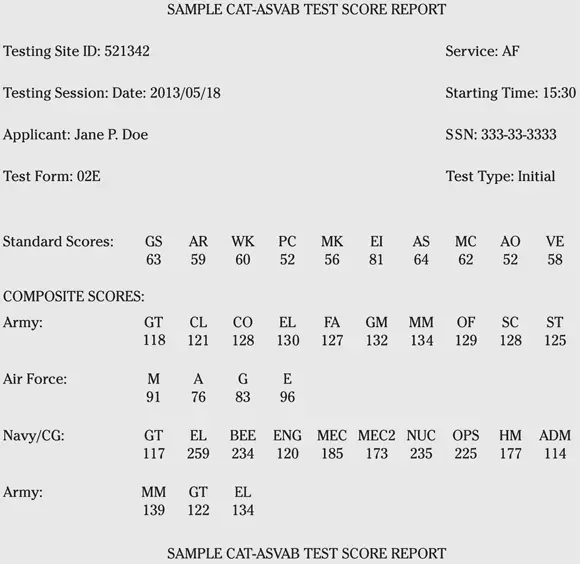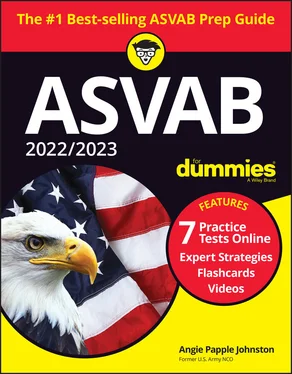Mapping Out the ASVAB Subtests
The computerized format of the ASVAB contains ten separately timed subtests, with the Auto & Shop Information subtest split in two. The paper format of the test has nine subtests (the Auto & Shop Information subtests are combined). The two formats differ in the number of questions in each subtest and the amount of time you have for each one. The CAT-ASVAB now often contains tryout questions. These questions haven’t been used on an officially scored ASVAB; test-makers use your responses to them to ensure the questions are good enough to use on future versions of the test. Each tester sees 15 tryout questions in two, three, or four of the subtests. These questions don’t count toward your score, but you still have to answer them. The tryout questions are only on the computerized version of the test; they’re not on the paper version. When you get tryout questions in a subtest, you get extra time to complete it.
Table 1-2outlines the ASVAB subtests in the order that you take them in the enlistment (computerized or paper) and student (paper only) versions of the test; you can also see which chapters to turn to when you want to review that content.
TABLE 1-2The ASVAB Subtests in Order
| Subtest |
Questions/Time without Tryout Questions (CAT-ASVAB) |
Possible Questions/Time with Tryout Questions (CAT-ASVAB) |
Questions/Time (Paper Version) |
Content |
Chapter |
| General Science (GS) |
15 questions, 10 minutes |
30 questions, 20 minutes |
25 questions, 11 minutes |
General principles of biological and physical sciences |
Chapters 10, 11, and 12 |
| Arithmetic Reasoning (AR) |
15 questions, 55 minutes |
30 questions, 113 minutes |
30 questions, 36 minutes |
Word problems involving high school math concepts that require calculations |
Chapter 9 |
| Word Knowledge (WK) |
15 questions, 9 minutes |
30 questions, 18 minutes |
35 questions, 11 minutes |
Correct meaning of a word; occasionally antonyms (words with opposite meanings) |
Chapter 4 |
| Paragraph Comprehension (PC) |
10 questions, 27 minutes |
25 questions, 75 minutes |
15 questions, 13 minutes |
Questions based on passages (usually a couple of hundred words) that you read |
Chapter 5 |
| Mathematics Knowledge (MK) |
15 questions, 23 minutes |
30 questions, 47 minutes |
25 questions, 24 minutes |
High school math, including algebra and geometry |
Chapters 6, 7, and 8 |
| Electronics Information (EI) |
15 questions, 10 minutes |
30 questions, 21 minutes |
20 questions, 9 minutes |
Electrical principles, basic electronic circuitry, and electronic terminology |
Chapter 16 |
| Auto & Shop Information (AS) |
10 Auto Information questions, 7 minutes; 10 Shop Information questions, 6 minutes |
25 Auto Information questions, 18 minutes; 25 Shop Information questions, 17 minutes |
25 questions, 11 minutes |
Knowledge of automobiles, shop terminology, and tool use |
Chapters 13and 14 |
| Mechanical Comprehension (MC) |
15 questions, 22 minutes |
30 questions, 42 minutes |
25 questions, 19 minutes |
Basic mechanical and physical principles |
Chapter 15 |
| Assembling Objects (AO) * |
15 questions, 17 minutes |
30 questions, 36 minutes |
25 questions, 15 minutes |
Spatial orientation |
Chapter 17 |
*The Assembling Objects subtest isn’t part of the student version of the test.
Eyeing Easy, Medium, and Hard Questions
The questions on the ASVAB range in difficulty from easy to hard, with most falling somewhere in the middle. On the paper-and-pencil version of the test, questions are presented in random order. For instance, you may see a hard question right off the bat, followed by a pair of easy questions and then a medium question. On the CAT-ASVAB, which I cover in more detail in Chapter 3, the questions you have to answer depend on how well you’re performing on the test. If you answer an easy question correctly, the computer will most likely give you a question of medium difficulty next; if you answer that one right, the next question is probably going to be harder.
 The CAT-ASVAB is designed to figure out what you know in the shortest amount of time possible. That’s why some people believe the ASVAB is harder (or in some cases, easier) than they thought it would be. Essentially, the test says, “This applicant knows that 5 + 5 = 10, so let’s see whether they know what x represents in the equation
The CAT-ASVAB is designed to figure out what you know in the shortest amount of time possible. That’s why some people believe the ASVAB is harder (or in some cases, easier) than they thought it would be. Essentially, the test says, “This applicant knows that 5 + 5 = 10, so let’s see whether they know what x represents in the equation  . No? Okay — let’s see whether they know what 10 – 5 equals.”
. No? Okay — let’s see whether they know what 10 – 5 equals.”
The Department of Defense is an official U.S. Government agency, so (of course) it provides plenty of detail regarding your scores. When you receive your ASVAB score results, you don’t see just one score; you see several. Figure 1-1 shows an example of an ASVAB score card used by high school guidance counselors (for people who take the student version — see “ Knowing Which Version You’re Taking” for details).

© John Wiley & Sons, Inc.
FIGURE 1-1:A sample ASVAB score card used by high school guidance counselors.
Figure 1-2 depicts an example of an ASVAB score card used for military enlistment purposes.
So what do all these different scores actually mean? Check out the following sections to find out.

© John Wiley & Sons, Inc.
FIGURE 1-2:A sample ASVAB score card used for military enlistment purposes.
When you take a test in high school, you usually receive a score that’s pretty easy to understand — A, B, C, D, or F. (If you do really well, the teacher may even draw a smiley face on the top of the page.) If only your ASVAB scores were as easy to understand.
In the following list, you see how your ASVAB test scores result in several different kinds of scores:
Raw score: This score is the total number of points you receive on each subtest of the ASVAB. Although you don’t see your raw scores on the ASVAB score cards, they’re used to calculate the other scores. You can’t use the practice tests in this book (or any other ASVAB study guide) to calculate your probable ASVAB score. ASVAB scores are calculated by using raw scores, and raw scores aren’t determined by adding the number of right or wrong answers. On the actual ASVAB, harder questions are worth more points than easier questions are.
Standard scores: The various subtests of the ASVAB are reported on the score cards as standard scores. A standard score is calculated by converting your raw score based on a standard distribution of scores with a mean of 50 and a standard deviation of 10. Don’t confuse a standard score with the graded-on-a-curve score you may have seen on school tests — where the scores range from 1 to 100 with the majority of students scoring between 70 and 100. With standard scores, the majority score is between 30 and 70. That means that a standard score of 50 is an average score and that a score of 60 is an above-average score.
Читать дальше

 The CAT-ASVAB is designed to figure out what you know in the shortest amount of time possible. That’s why some people believe the ASVAB is harder (or in some cases, easier) than they thought it would be. Essentially, the test says, “This applicant knows that 5 + 5 = 10, so let’s see whether they know what x represents in the equation
The CAT-ASVAB is designed to figure out what you know in the shortest amount of time possible. That’s why some people believe the ASVAB is harder (or in some cases, easier) than they thought it would be. Essentially, the test says, “This applicant knows that 5 + 5 = 10, so let’s see whether they know what x represents in the equation  . No? Okay — let’s see whether they know what 10 – 5 equals.”
. No? Okay — let’s see whether they know what 10 – 5 equals.”












